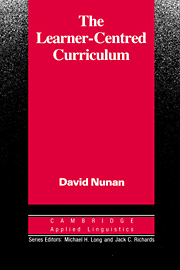Book contents
- Frontmatter
- Contents
- Series Editors' Preface
- Preface
- 1 Introduction
- 2 Curriculum Processes
- 3 Learner-Centred Curriculum Development
- 4 Pre-Course Planning Procedures
- 5 Planning Content
- 6 Methodology
- 7 Resources for a Learner-Centred Curriculum
- 8 Assessment and Evaluation
- 9 Evaluation and Professional Development
- 10 The Teacher as Curriculum Developer
- References
- Appendix
- Subject Index
- Author Index
Series Editors' Preface
Published online by Cambridge University Press: 05 April 2013
- Frontmatter
- Contents
- Series Editors' Preface
- Preface
- 1 Introduction
- 2 Curriculum Processes
- 3 Learner-Centred Curriculum Development
- 4 Pre-Course Planning Procedures
- 5 Planning Content
- 6 Methodology
- 7 Resources for a Learner-Centred Curriculum
- 8 Assessment and Evaluation
- 9 Evaluation and Professional Development
- 10 The Teacher as Curriculum Developer
- References
- Appendix
- Subject Index
- Author Index
Summary
Australia has one of the largest and most dynamic migrant education language programmes in the world. What makes the Australian Adult Migrant Education Program (AMEP) unique is that although the program is co-ordinated at the national level, the process of curriculum development it embodies is bottom up rather than top down. At each institution where migrant language programs are offered, learners are actively involved in setting their own goals and determining what and how they will learn. It is this experience which Dr David Nunan, director of the National Curriculum Resource Centre, Adelaide, presents in this important book.
This is more than just an account of the AMEP however. This book offers a model of what curriculum development is. David Nunan shows that curriculum development involves the interaction of needs analysis, goal setting, grading and sequencing of content, materials development, implementation and evaluation, and shows how these processes interact within a learner-centered approach to curriculum. Throughout, the discussion is illustrated with numerous examples from the AMEP experience. At the same time, Nunan demonstrates that curriculum work must move beyond speculation and have a solid empirical basis if it is to have any substance, and illustrates the use of questionnaire, interview and case study data in curriculum planning. In addition, Nunan demonstrates that language curriculum practitioners have much to learn from mainstream educational research and practice.
The AMEP is a unique example of a national curriculum project which attributes a central role to both teachers and learners at every phase of the curriculum process. As such, it should be examined carefully by all those involved in language curriculum work.
- Type
- Chapter
- Information
- The Learner-Centred CurriculumA Study in Second Language Teaching, pp. xPublisher: Cambridge University PressPrint publication year: 1988



